
- SAP Community
- Products and Technology
- Technology
- Technology Blogs by Members
- CRUDQ Using Fiori Elements(CDS, List Report, Objec...
Technology Blogs by Members
Explore a vibrant mix of technical expertise, industry insights, and tech buzz in member blogs covering SAP products, technology, and events. Get in the mix!
Turn on suggestions
Auto-suggest helps you quickly narrow down your search results by suggesting possible matches as you type.
Showing results for
styles
Explorer
Options
- Subscribe to RSS Feed
- Mark as New
- Mark as Read
- Bookmark
- Subscribe
- Printer Friendly Page
- Report Inappropriate Content
01-10-2024
8:45 AM
Introduction:
In this blog post you will understand:
Contents at a Glance
- Developing and Deploying a List Report (BAS & WEBIDE)
- CDS View Entity with metadata Definition
- Publishing and Activation of OData Service
- Create ,Preview and Deploy a list report project in WEBIDE
- Create ,Preview and Deploy a list report project in BAS
- Enabling CRUDQ operations using Annotations
- Enabling Multi Selection and Mass Editing Functionalities
Ultimate Goal: Mass Editing of Table entries in Fiori List report for a single data source.
Prerequisite:
- SAP BAS / WEBIDE installed on your BTP account with Fiori tools installed in your Dev space.
- S4HANA on-premise system you can connect to via https://blogs.sap.com/2020/09/17/how-sap-cloud-connector-works/
- Eclipse ADT https://tools.hana.ondemand.com/
1.Developing and Deploying a List Report (BAS & WEBIDE)
1.1 CDS View Entity with metadata Definition
In Eclipse ADT,
Right click on the package
New -> Other ABAP Repository Object

- In the Wizard Select Data Definition and click Next.
- Now, Provide the Prompted View details and Click Next.
- Select View Entity from the Template and Click on Finish.


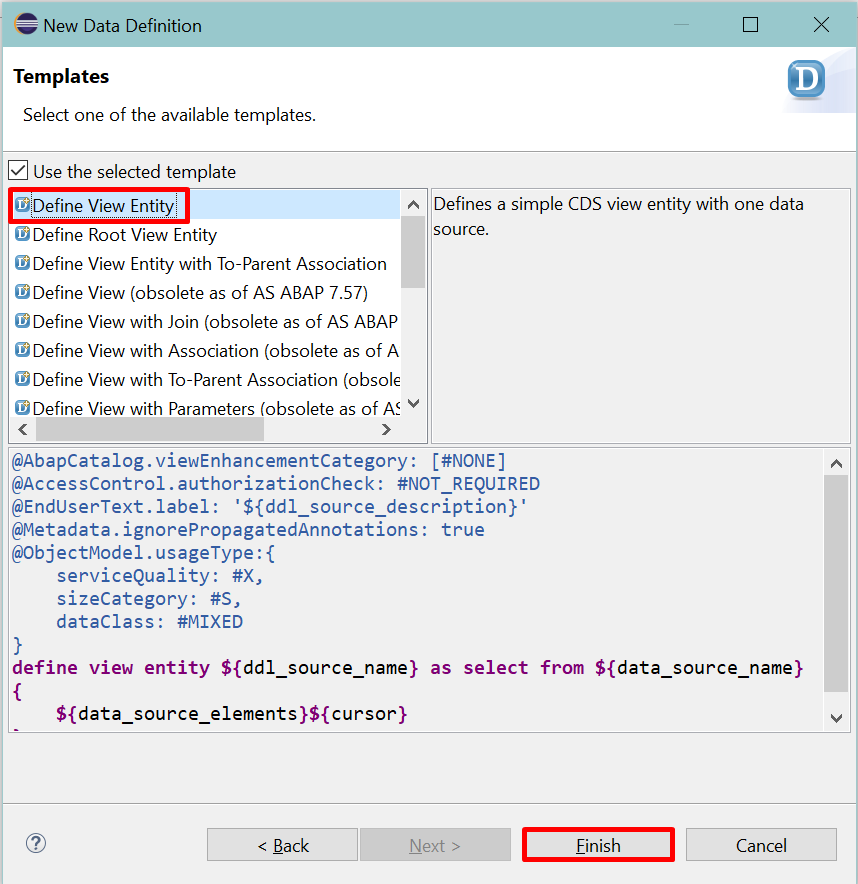
Table for which the CRUDQ is to be performed "YTABLE"

Below is the Code that fetches the value from the Data Source (CDS-Data Definition)
@AbapCatalog.viewEnhancementCategory: [#NONE]
@AccessControl.authorizationCheck: #NOT_REQUIRED
@EndUserText.label: 'CRUDQ Using Fiori Elements'
@Metadata.ignorePropagatedAnnotations: true
@ObjectModel.usageType:{
serviceQuality: #X,
sizeCategory: #S,
dataClass: #MIXED
}
define view entity YV_TABLE_CRUDQ
as select from ytable
{
key field1,
field2,
field3,
field4,
field5
}
Now Save (Ctrl + S), Check (Ctrl+F2) and Activate (Ctrl + F3).
Execute(F8) the CDS to preview the data.

Now the CDS can be published and Activated as OData Service but the Result in the List report will not be User-Friendly without the UI Definition.
This is where UI Annotations plays a key role.
Metadata Extension
What is Metadata Extensions?
A CDS metadata extension (MDE) extends a CDS entity with CDS annotations that are not specified in the DDL source code of the data definition.
CDS metadata extensions can currently only be created for CDS views.
Adding Annotations to the View using Metadata Extension.
Right click on the package
New -> Other ABAP Repository Object
- In the Wizard Select Metadata Extension and click Next.
- Now, Provide the Prompted details and Click Next.
- Select Annotate View from the Template and Click on Finish.



Once the Metadata Extension is created, the below error message is Expected.
Annotation 'Metadata.allowExtensions' missing in 'YV_TABLE_CRUDQ'
In order to overcome this error, add the annotation "@Metadata.allowExtensions: true" in the CDS View.
Once the error is rectified come back to Metadata Extension. Below is the metadata Extension Code.
@Metadata.layer: #PARTNER
@UI.headerInfo: {typeName: 'Entry', typeNamePlural: 'Entries', title: {label: 'Happy Learning'}}
annotate view YV_TABLE_CRUDQ with
{
@EndUserText.label: '1st Field'
@UI: {
selectionField: [{ position: 10 }],
lineItem: [{ position: 10}, { cssDefault.width: '8rem' } ],
identification: [{position: 10}]
}
field1;
@EndUserText.label: '2nd Field'
@UI: {
selectionField: [{ position: 20 }],
lineItem: [{ position: 20}, { cssDefault.width: '8rem' } ],
identification: [{position: 20}]
}
field2;
@EndUserText.label: '3rd Field'
@UI: {
lineItem: [{ position: 30}, { cssDefault.width: '8rem' } ],
identification: [{position: 30}]
}
field3;
@EndUserText.label: '4th Field'
@UI: {
lineItem: [{ position: 40}, { cssDefault.width: '8rem' } ],
identification: [{position: 40}]
}
field4;
@EndUserText.label: '5th Field'
@UI: {
lineItem: [{ position: 50}, { cssDefault.width: '8rem' } ],
identification: [{position: 50}]
}
field5;
}Annotation Explanation:
- @UI.headerInfo – Defines the Header value and no.of Entries fetched.
- @EndUserText.label – End-user Label (Field name that is displayed in the Application)
- @UI: {
- selectionField: [{ position: 10 }], - Defines the Field as Input
- lineItem: [{ position: 10}, - Defines the Column in the List report
- { cssDefault.width: '8rem' } ], - Defines the Width of the Column
- identification: [{position: 10}] - Defines the position in the Object page
- }
Once the Metadata Extension is done Save and Activate it.
1.2.Publishing and Activation of OData Service
@OData.publish: trueAdding this annotation will publish the OData automatically, once the View is Saved and Activated.
Note: The Service name will be same as the View name with the suffix "_CDS".
In this case "YV_TABLE_CRUDQ_CDS"
Once all the annotations are done the code will look like Below⇓ (List Report)
//Data Definition
@AbapCatalog.viewEnhancementCategory: [#NONE]
@AccessControl.authorizationCheck: #NOT_REQUIRED
@EndUserText.label: 'CRUDQ Using Fiori Elements'
@Metadata.ignorePropagatedAnnotations: true
@Metadata.allowExtensions: true
@ObjectModel.usageType:{
serviceQuality: #X,
sizeCategory: #S,
dataClass: #MIXED
}
@OData.publish: true
define view entity YV_TABLE_CRUDQ
as select from ytable
{
key field1,
field2,
field3,
field4,
field5
}
_______________________________________________________________________________________________________
// Metadata Extension
@Metadata.layer: #PARTNER
@UI.headerInfo: {typeName: 'Entry', typeNamePlural: 'Entries', title: {label: 'Happy Learning'}}
annotate view YV_TABLE_CRUDQ with
{
@EndUserText.label: '1st Field'
@UI: {
selectionField: [{ position: 10 }],
lineItem: [{ position: 10}, { cssDefault.width: '8rem' } ],
identification: [{position: 10}]
}
field1;
@EndUserText.label: '2nd Field'
@UI: {
selectionField: [{ position: 20 }],
lineItem: [{ position: 20}, { cssDefault.width: '8rem' } ],
identification: [{position: 20}]
}
field2;
@EndUserText.label: '3rd Field'
@UI: {
lineItem: [{ position: 30}, { cssDefault.width: '8rem' } ],
identification: [{position: 30}]
}
field3;
@EndUserText.label: '4th Field'
@UI: {
lineItem: [{ position: 40}, { cssDefault.width: '8rem' } ],
identification: [{position: 40}]
}
field4;
@EndUserText.label: '5th Field'
@UI: {
lineItem: [{ position: 50}, { cssDefault.width: '8rem' } ],
identification: [{position: 50}]
}
field5;
}
Activation of the Service.
Logon to you SAP system.
TCODE: /n/iwfnd/maint_service
- Go to "Add Service"

- Provide the Alias, Service Name and Press Enter
- Select the Line item and Click on Add Selected Service
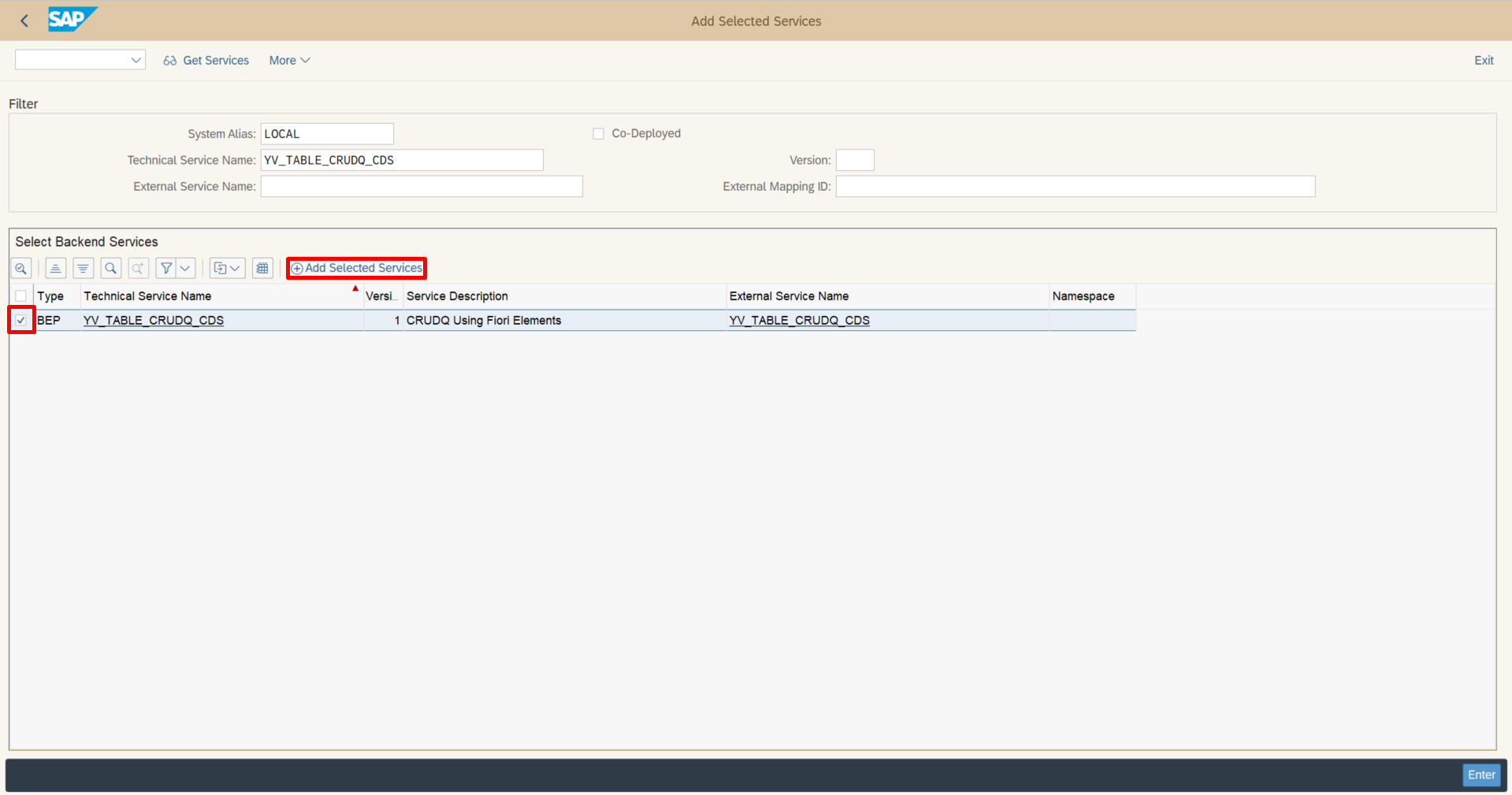
- In the Wizard, provide the Package Details and Continue
- The Service can be tested in the gateway client if Required.
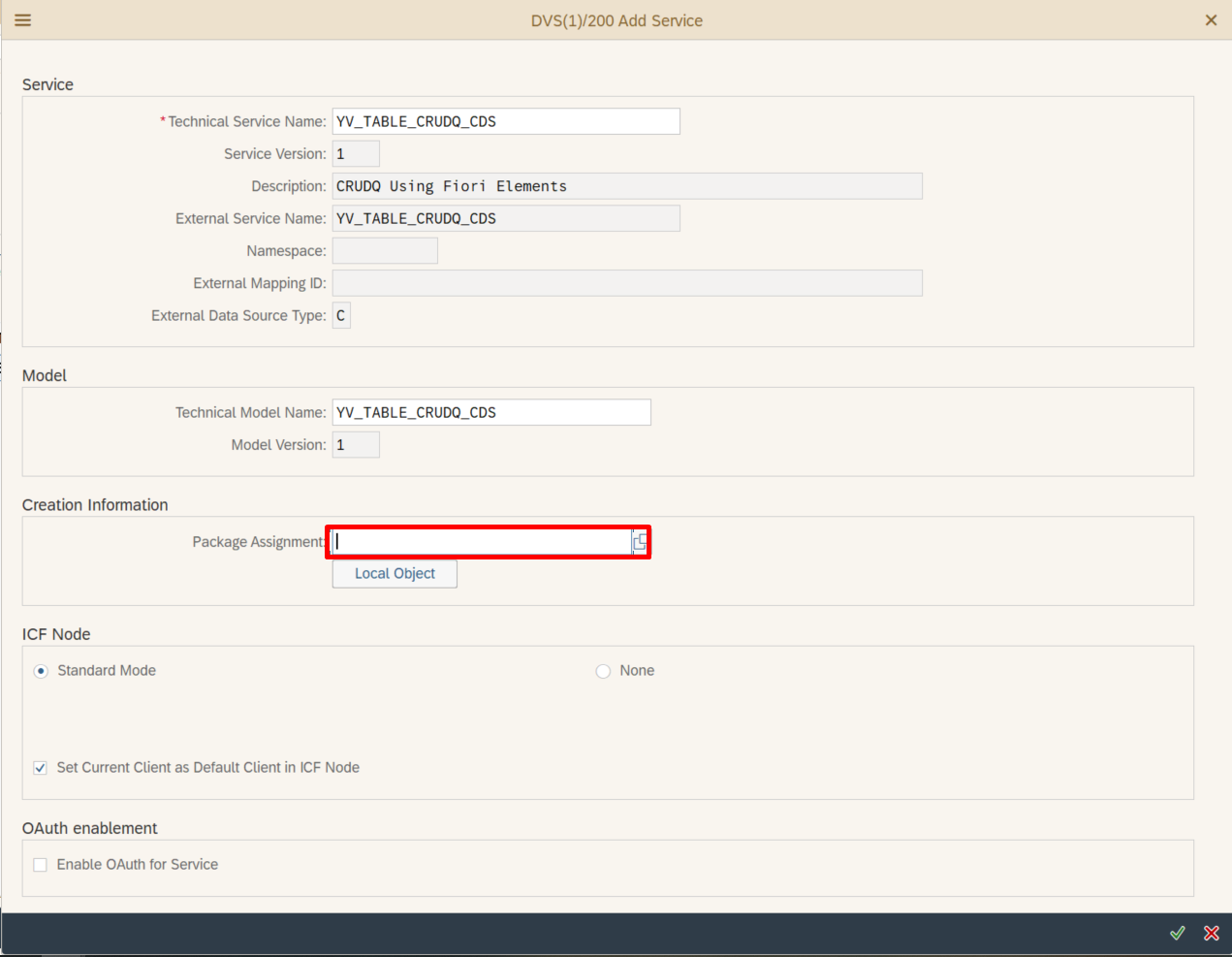
1.3 Create, Preview and Deploy a list report project in WEBIDE
Logon to BTP Account and go to WEBIDE Service
File->New->Project from Template

Select List Report Application and click on Next
( If List Report Application is not displayed, alter the category as SAP Fiori Elements or try Changing the filter conditions)

Project Details
Data Connection - Binding your Service to the Application

Annotation Selection
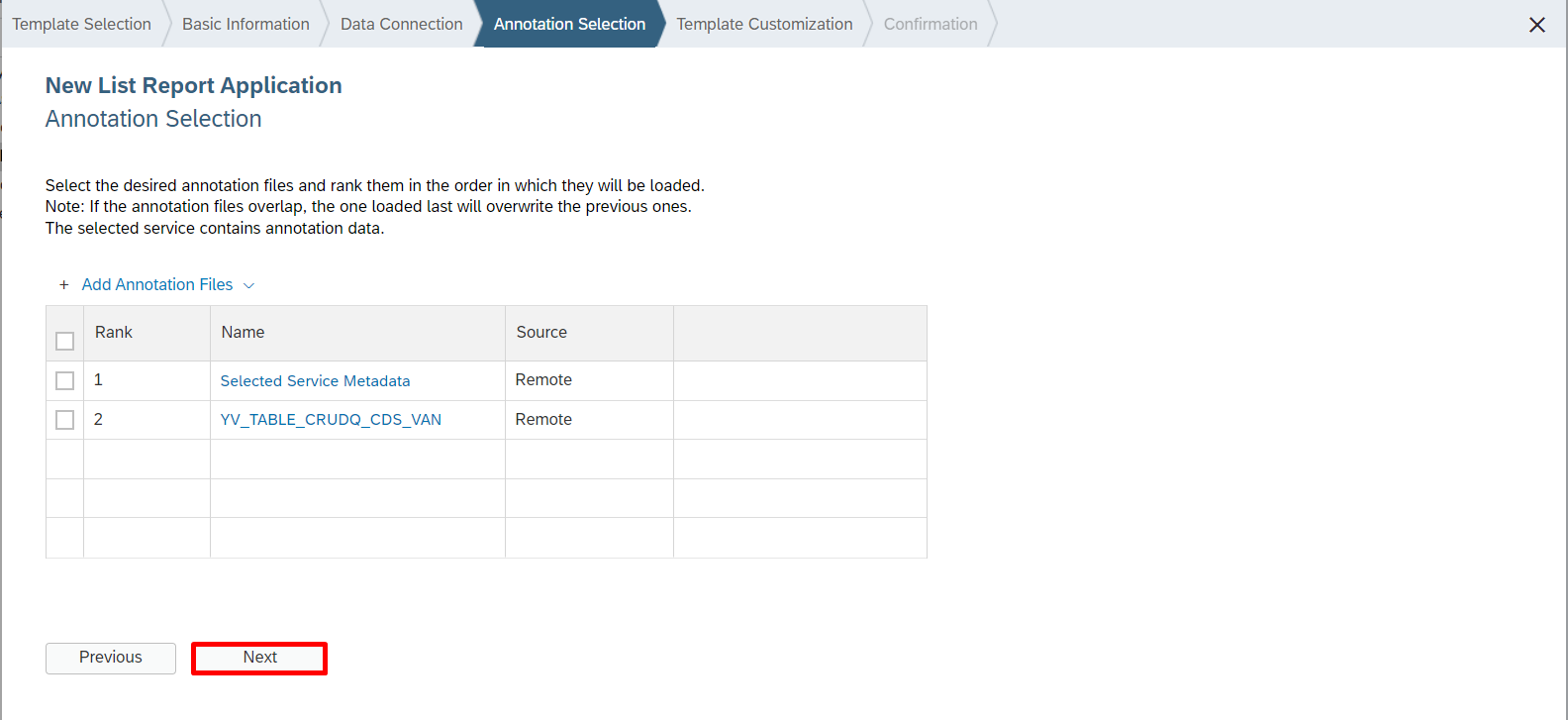
Entity Set Selection
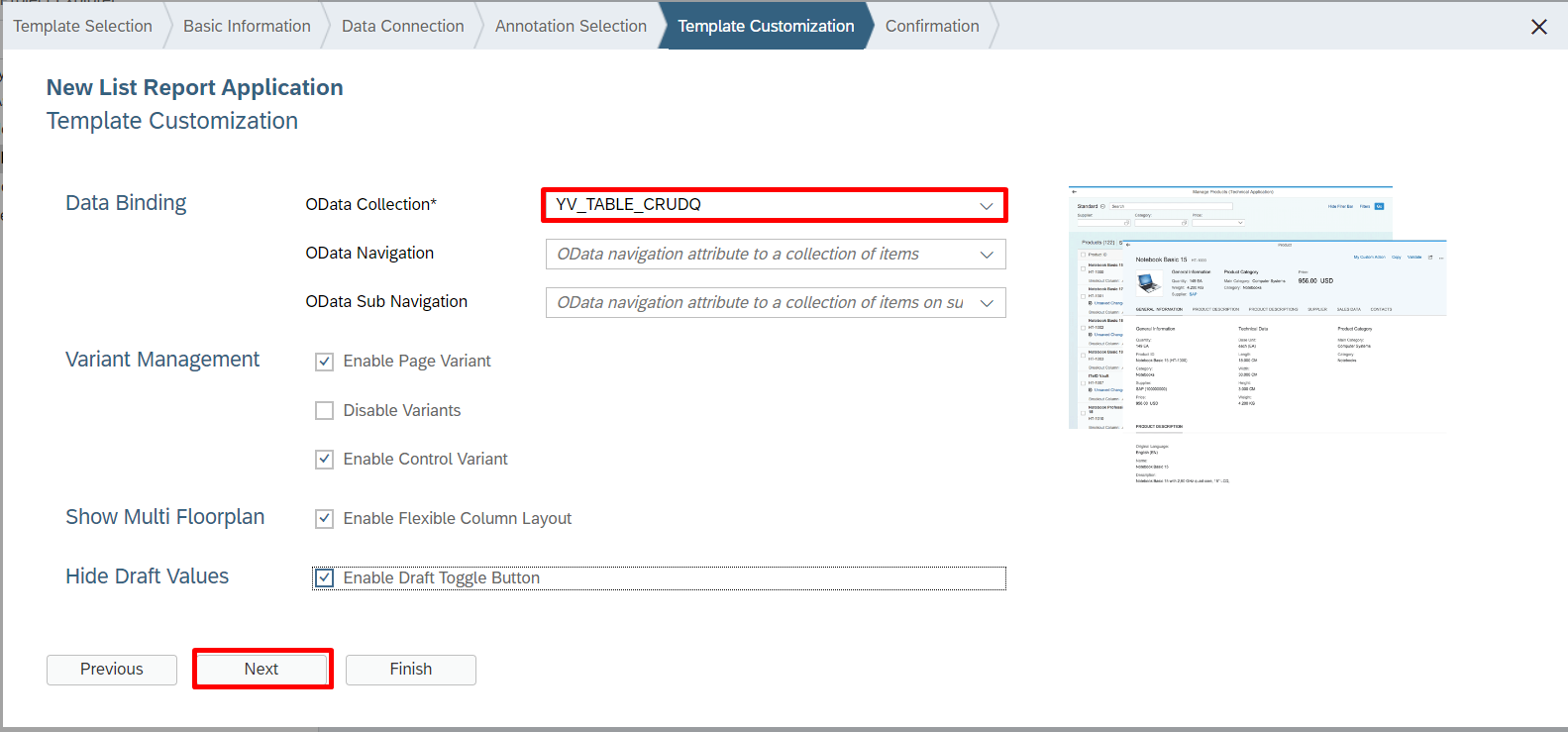
Confirmation

Once the Project is created, Run the Application.
If you encounter metadata failed error. Then Do as stated below.

Replace the Metadata URL Param SAP-VALUE-LIST as "all" from "none" in MANIFEST.JSON from your Application under webapp.
This Step is recommended to do,
"metadataUrlParams": {
"sap-value-list": "all"
}Now try to Run your Application.
Application Preview:

Tip: The Table Type can be changed in MANIFEST.JSON
"settings": { "tableSettings": { "type": "GridTable" }
Table types Available:
ResponsiveTable (default)
GridTable
AnalyticalTable
TreeTable
Code Snippet on Table type⇓
"sap.ui.generic.app": {
"pages": [{
"entitySet": "ZXXXXXXXX",
"component": {
"name": "sap.suite.ui.generic.template.ListReport",
"list": true,
"settings": {
"tableSettings": {
"type": "GridTable"
}
}
},Now the application is ready to Deploy.
Right click on the Project
Deploy->Deploy to SAP ABAP Repository
Provide the Deployment Details and Finish the Process.
Tile Creation, FLP Configuration and Role creations are to be done Respectively, which is not covered in this Blog.
1.4 Create, Preview and Deploy a List report project in BAS
Logon to BTP and open Business Application Studio (BAS) in Instance and Subscriptions.
The DEV Space should be SAP Fiori
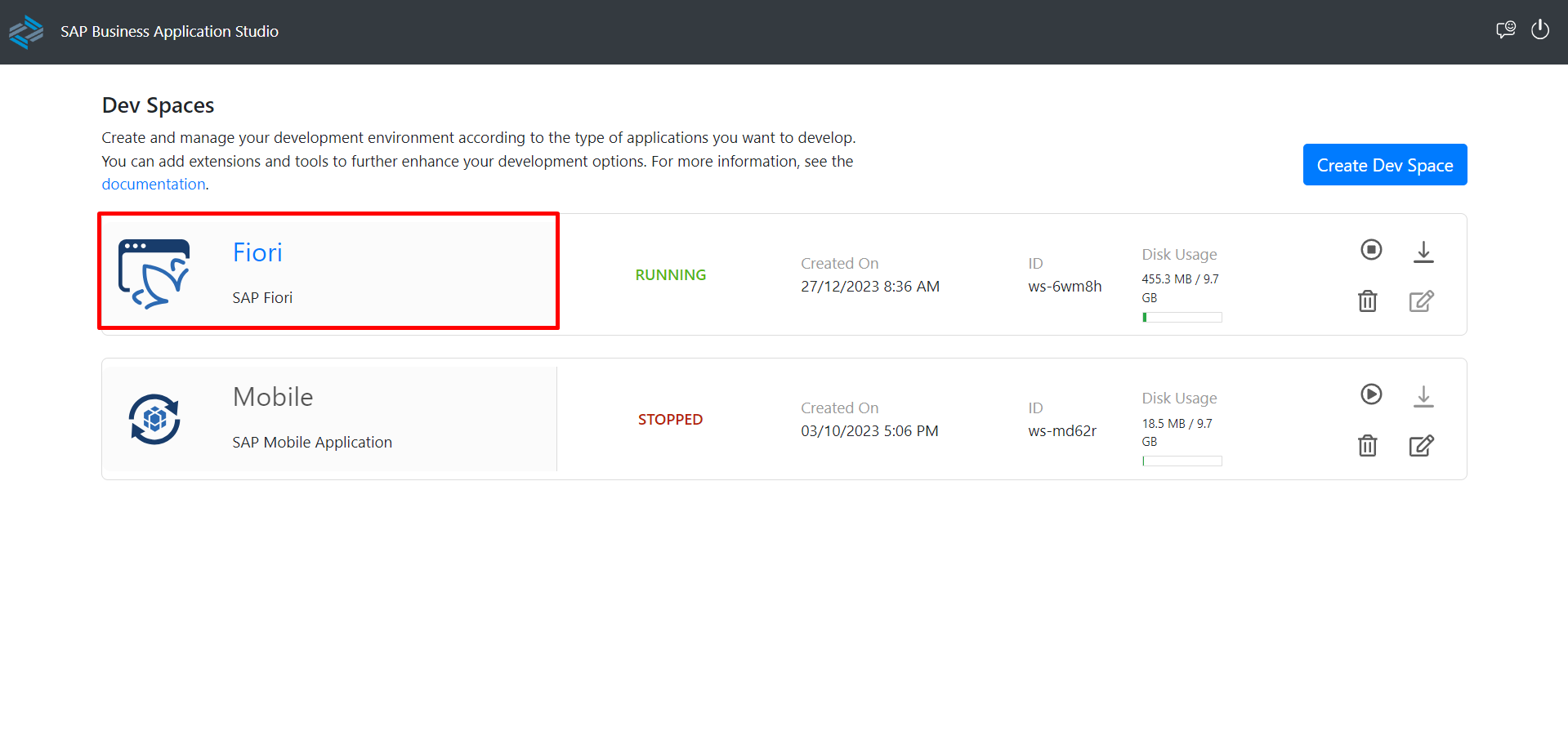
Now, to create a new Project
File->New Project from Template

Select SAP Fiori Application & Start

Select List Report Page & Next.

Data Source and Entity Selection, provide the Prompted values as below and proceed Further.
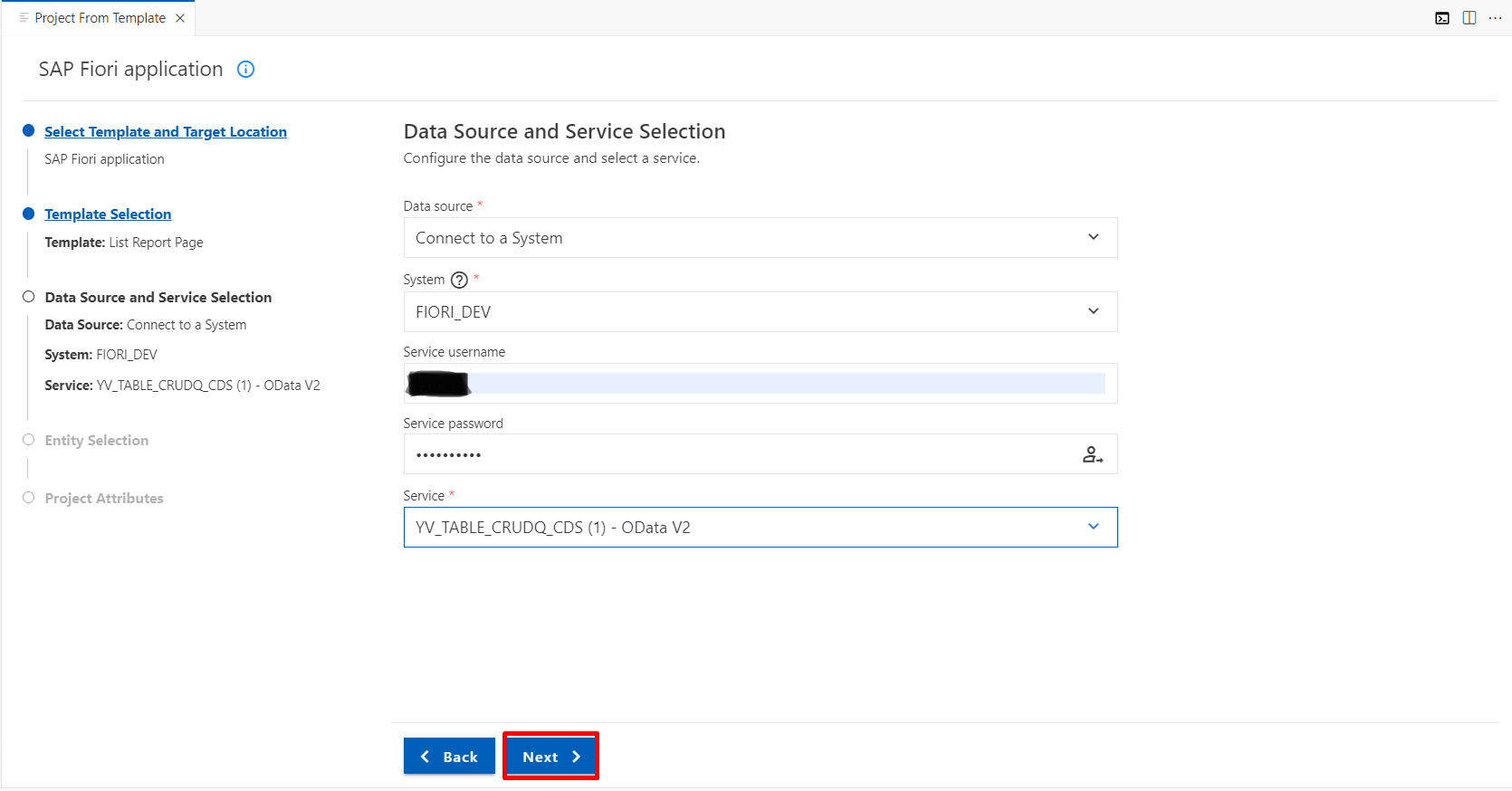

Now provide the Project Details,
In BAS, we can add Deployment & FLP Configurations as well, during project creation

Deployment Configurations
For Package and TR (Transport Request) details - it can be manually entered.

FLP Configurations
Provide the Tile Details and Click on Finish

Previewing the Application
Once the project is Created.
Right Click on the project and Select Preview Application.
Select Start Fiori Run from the preview options,
If in case you are unable to preview the Application, Select Start-noflp.

Application Preview

Deployment Steps
Right Click on your Project -> Open in Integrated Terminal, then enter the Below command
npm run deploy
Now, it will ask you for the Confirmation with Deployment details, proceed with 'Y'

Enter in your S4HANA Credentials and Proceed.
Now you will get the Deployment Success Message
info abap-deploy-task ZBSP_CRUD_CDS Deployment Successful.2.Enabling CRUDQ operations using Annotations
In this we are going to Achieve CRUDQ Using Object Model aka BOPF.
Add the below annotations to your CDS Data Definition (Note: Cannot be done in Metadata Extension)
@ObjectModel:{
modelCategory: #BUSINESS_OBJECT,
compositionRoot: true,
representativeKey: 'field1',
semanticKey: ['field1'],
transactionalProcessingEnabled: true,
writeActivePersistence: 'YTABLE',
// enable crud
createEnabled: true,
updateEnabled: true,
deleteEnabled: true
}Now add the below ⇓ Annotation in Metadata Extension to Enable Object Page.
@UI.facet: [
{
label: 'Edit Values',
position: 10,
type: #COLLECTION,
id: 'GeneralInfo'
},
{
label: 'Edit',
purpose: #STANDARD,
position: 10,
type: #IDENTIFICATION_REFERENCE,
parentId: 'GeneralInfo'
}
]Boom !!!, Now the CRUDQ functionality is enabled in the Application
Preview:
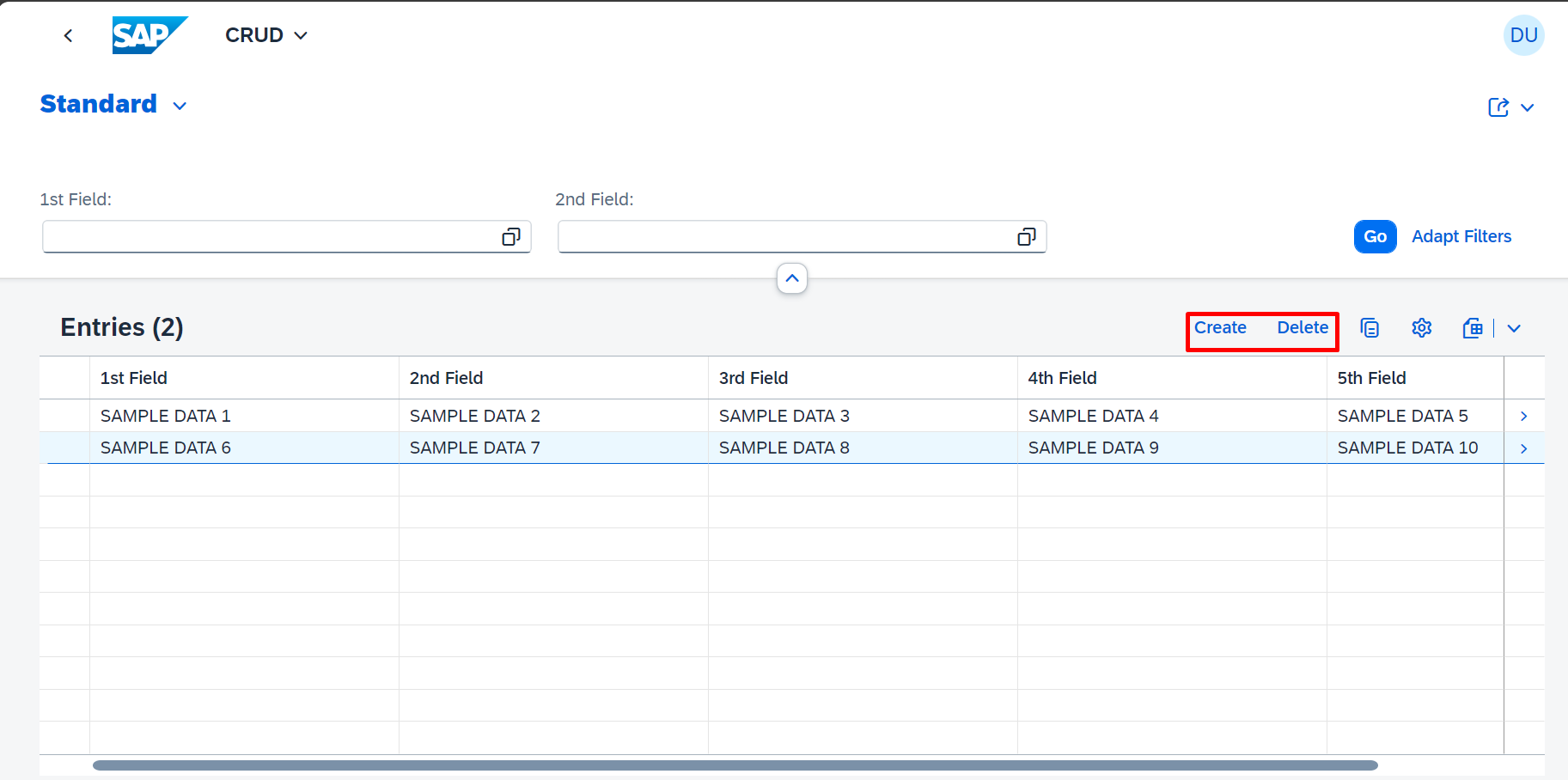

3.Enabling Multi Selection and Mass Editing Functionalities
Now we are going to achieve Multiple Selection and Mass editing
In MANIFEST.JSON add the below snippets for respective functionalities
"tableSettings": {
"multiSelect": true,
"multiEdit": { "enabled" : true }
},
Code Snippet on Multi Selection and Mass Editing ⇓
"sap.ui.generic.app": {
"pages": [{
"entitySet": "ZXXXXXXXX",
"component": {
"name": "sap.suite.ui.generic.template.ListReport",
"list": true,
"settings": {
"tableSettings": {
"multiSelect": true,
"multiEdit": { "enabled" : true }
}
}
},Preview :
Note: Mass edit with Dialog work only with Responsive Table Type

Mass Edit with Dialog:

To understand how Mass Edit with Dialog works and guidelines follow this link:
https://experience.sap.com/fiori-design-web/mass-editing/
Conclusion:
From this Blog we can understand:
How a List Report is built and deployed, How CRUDQ functionalities are enabled with Multi Selection and Mass Edit in a single shot.
"Programming is not about what we know, its about what we can solve"
Regards,
Styles
- SAP Managed Tags:
- SAP Fiori Elements
4 Comments
You must be a registered user to add a comment. If you've already registered, sign in. Otherwise, register and sign in.
Labels in this area
-
"automatische backups"
1 -
"regelmäßige sicherung"
1 -
"TypeScript" "Development" "FeedBack"
1 -
505 Technology Updates 53
1 -
ABAP
19 -
ABAP API
1 -
ABAP CDS Views
4 -
ABAP CDS Views - BW Extraction
1 -
ABAP CDS Views - CDC (Change Data Capture)
1 -
ABAP class
2 -
ABAP Cloud
3 -
ABAP DDIC CDS view
1 -
ABAP Development
5 -
ABAP in Eclipse
3 -
ABAP Platform Trial
1 -
ABAP Programming
2 -
abap technical
1 -
abapGit
1 -
absl
2 -
access data from SAP Datasphere directly from Snowflake
1 -
Access data from SAP datasphere to Qliksense
1 -
Accrual
1 -
action
1 -
adapter modules
1 -
Addon
1 -
Adobe Document Services
1 -
ADS
1 -
ADS Config
1 -
ADS with ABAP
1 -
ADS with Java
1 -
ADT
2 -
Advance Shipping and Receiving
1 -
Advanced Event Mesh
3 -
Advanced formula
1 -
AEM
1 -
AI
8 -
AI Launchpad
1 -
AI Projects
1 -
AIML
10 -
Alert in Sap analytical cloud
1 -
Amazon S3
1 -
Analytic Models
1 -
Analytical Dataset
1 -
Analytical Model
1 -
Analytics
1 -
Analyze Workload Data
1 -
annotations
1 -
API
1 -
API and Integration
4 -
API Call
2 -
API security
1 -
Application Architecture
1 -
Application Development
5 -
Application Development for SAP HANA Cloud
3 -
Applications and Business Processes (AP)
1 -
Architecture
1 -
Artificial Intelligence
1 -
Artificial Intelligence (AI)
6 -
Artificial Intelligence (AI) 1 Business Trends 363 Business Trends 8 Digital Transformation with Cloud ERP (DT) 1 Event Information 462 Event Information 15 Expert Insights 114 Expert Insights 76 Life at SAP 418 Life at SAP 1 Product Updates 4
1 -
Artificial Intelligence (AI) blockchain Data & Analytics
1 -
Artificial Intelligence (AI) blockchain Data & Analytics Intelligent Enterprise
1 -
Artificial Intelligence (AI) blockchain Data & Analytics Intelligent Enterprise Oil Gas IoT Exploration Production
1 -
Artificial Intelligence (AI) blockchain Data & Analytics Intelligent Enterprise sustainability responsibility esg social compliance cybersecurity risk
1 -
AS Java
1 -
ASE
1 -
ASR
2 -
Asset Management
2 -
Associations in CDS Views
1 -
ASUG
1 -
Attachments
1 -
Authentication
1 -
Authorisations
1 -
Authorizations
1 -
Automate the Interim Account Update rule using Integration Center Job (Time Off)
1 -
Automating Processes
1 -
Automation
2 -
aws
2 -
Azure
2 -
Azure AI Studio
1 -
Azure API Center
1 -
Azure API Management
1 -
B2B Integration
1 -
Background job
1 -
Backorder Processing
1 -
Backpropagation
1 -
Backup
1 -
Backup and Recovery
1 -
Backup schedule
1 -
BADI_MATERIAL_CHECK error message
1 -
Bank
1 -
Bank Communication Management
1 -
BAS
1 -
basis
2 -
Basis Monitoring & Tcodes with Key notes
2 -
Batch Management
1 -
BDC
1 -
Best Practice
1 -
BI
1 -
bitcoin
1 -
Blockchain
3 -
bodl
1 -
BOP in aATP
1 -
BOP Segments
1 -
BOP Strategies
1 -
BOP Variant
1 -
BPC
1 -
BPC LIVE
1 -
BTP
17 -
BTP AI Launchpad
1 -
BTP Destination
2 -
BTP for Sustainability
1 -
Business AI
1 -
Business and IT Integration
1 -
Business application stu
1 -
Business Application Studio
1 -
Business Architecture
1 -
Business Communication Services
1 -
Business Continuity
2 -
Business Data Fabric
3 -
Business Fabric
1 -
Business Partner
13 -
Business Partner Master Data
11 -
Business Technology Platform
2 -
Business Trends
4 -
BW4HANA
1 -
C4C cloud root certificate
1 -
CA
1 -
calculation view
1 -
CAP
5 -
CAP development
1 -
Capgemini
1 -
CAPM
1 -
Catalyst for Efficiency: Revolutionizing SAP Integration Suite with Artificial Intelligence (AI) and
1 -
CCMS
2 -
CDQ
13 -
CDS
2 -
CDS Views
1 -
Cental Finance
1 -
Certificates
1 -
CFL
1 -
Change Management
1 -
chatbot
1 -
chatgpt
3 -
CICD
1 -
CL_SALV_TABLE
2 -
Class Runner
1 -
Classrunner
1 -
Cloud ALM Monitoring
1 -
Cloud ALM Operations
1 -
cloud connector
1 -
Cloud Extensibility
1 -
Cloud Foundry
4 -
Cloud Integration
6 -
Cloud Platform Integration
2 -
cloudalm
1 -
communication
1 -
Compensation Information Management
1 -
Compensation Management
1 -
Compliance
1 -
Compound Employee API
1 -
Configuration
1 -
Connectors
1 -
Consolidation
1 -
Consolidation Extension for SAP Analytics Cloud
3 -
Control Indicators.
1 -
Controller-Service-Repository pattern
1 -
Conversion
1 -
Corrective Maintenance
1 -
Cosine similarity
1 -
CPI
2 -
cryptocurrency
1 -
CSI
1 -
ctms
1 -
Custom chatbot
3 -
Custom Destination Service
1 -
custom fields
1 -
Custom Headers
1 -
Customer Experience
1 -
Customer Journey
1 -
Customizing
1 -
cyber security
5 -
cybersecurity
1 -
Data
1 -
Data & Analytics
1 -
Data Aging
1 -
Data Analytics
2 -
Data and Analytics (DA)
1 -
Data Archiving
1 -
Data Back-up
1 -
Data Flow
1 -
Data Governance
5 -
Data Integration
2 -
Data Quality
13 -
Data Quality Management
13 -
Data Synchronization
1 -
data transfer
1 -
Data Unleashed
1 -
Data Value
9 -
Database
1 -
Database and Data Management
1 -
database tables
1 -
Databricks
1 -
Dataframe
1 -
Datasphere
4 -
Datasphere Delta
1 -
datenbanksicherung
1 -
dba cockpit
1 -
dbacockpit
1 -
Debugging
2 -
Defender
1 -
Delimiting Pay Components
1 -
Delta Integrations
1 -
Destination
3 -
Destination Service
1 -
Developer extensibility
1 -
Developing with SAP Integration Suite
1 -
Devops
1 -
digital transformation
1 -
Disaster Recovery
1 -
Documentation
1 -
Dot Product
1 -
DQM
1 -
dump database
1 -
dump transaction
1 -
e-Invoice
1 -
E4H Conversion
1 -
Eclipse ADT ABAP Development Tools
2 -
edoc
1 -
edocument
1 -
ELA
1 -
Embedded Consolidation
1 -
Embedding
1 -
Embeddings
1 -
Emergency Maintenance
1 -
Employee Central
1 -
Employee Central Payroll
1 -
Employee Central Time Off
1 -
Employee Information
1 -
Employee Rehires
1 -
Enable Now
1 -
Enable now manager
1 -
endpoint
1 -
Enhancement Request
1 -
Enterprise Architecture
2 -
Enterprise Asset Management
2 -
Entra
1 -
ESLint
1 -
ETL Business Analytics with SAP Signavio
1 -
Euclidean distance
1 -
Event Dates
1 -
Event Driven Architecture
1 -
Event Mesh
2 -
Event Reason
1 -
EventBasedIntegration
1 -
EWM
1 -
EWM Outbound configuration
1 -
EWM-TM-Integration
1 -
Existing Event Changes
1 -
Expand
1 -
Expert
2 -
Expert Insights
2 -
Exploits
1 -
Fiori
16 -
Fiori App Extension
2 -
Fiori Elements
2 -
Fiori Launchpad
2 -
Fiori SAPUI5
13 -
first-guidance
2 -
Flask
2 -
Fragment Forms
1 -
Fragment Forms using ABA[
1 -
FTC
1 -
Full Stack
9 -
Funds Management
1 -
gCTS
1 -
GenAI hub
1 -
General
3 -
Generative AI
1 -
Getting Started
1 -
GitHub
11 -
Google cloud
1 -
Grants Management
1 -
groovy
2 -
GTP
1 -
HANA
6 -
HANA Cloud
3 -
hana cloud database
2 -
Hana Cloud Database Integration
2 -
HANA DB
2 -
Hana Vector Engine
1 -
HANA XS Advanced
1 -
HanaDB
1 -
Historical Events
1 -
home labs
1 -
HowTo
1 -
HR Data Management
1 -
html5
9 -
HTML5 Application
1 -
Identity cards validation
1 -
idm
1 -
Implementation
1 -
Improvement Maintenance
1 -
Infuse AI
1 -
input parameter
1 -
instant payments
1 -
Integration
3 -
Integration Advisor
1 -
Integration Architecture
1 -
Integration Center
1 -
Integration Suite
1 -
intelligent enterprise
1 -
Internal Table
1 -
IoT
2 -
Java
1 -
Java Script
1 -
JMS Receiver channel ping issue
1 -
job
1 -
Job Information Changes
1 -
Job-Related Events
1 -
Job_Event_Information
1 -
joule
4 -
Journal Entries
1 -
Just Ask
1 -
Kafka
1 -
Kerberos for ABAP
10 -
Kerberos for JAVA
9 -
KNN
1 -
Launch Wizard
1 -
Learning Content
3 -
Life at SAP
4 -
lightning
1 -
Linear Regression SAP HANA Cloud
1 -
Live Sessions
1 -
Loading Indicator
1 -
local tax regulations
1 -
LP
1 -
Machine Learning
4 -
Marketing
1 -
Master Data
3 -
Master Data Management
15 -
Maxdb
2 -
MDG
1 -
MDGM
1 -
MDM
1 -
Message box.
1 -
Messages on RF Device
1 -
Microservices Architecture
1 -
Microsoft
1 -
Microsoft Universal Print
1 -
Middleware Solutions
1 -
Migration
5 -
ML Model Development
1 -
MLFlow
1 -
Modeling in SAP HANA Cloud
9 -
Monitoring
3 -
MPL
1 -
MTA
1 -
Multi-factor-authentication
1 -
Multi-Record Scenarios
1 -
Multilayer Perceptron
1 -
Multiple Event Triggers
1 -
Myself Transformation
1 -
Neo
1 -
NetWeaver
1 -
Neural Networks
1 -
New Event Creation
1 -
New Feature
1 -
Newcomer
1 -
NodeJS
3 -
ODATA
2 -
OData APIs
1 -
odatav2
1 -
ODATAV4
1 -
ODBC
1 -
ODBC Connection
1 -
Onpremise
1 -
open source
2 -
OpenAI API
1 -
Optimized Story Experience
1 -
Oracle
1 -
Overhead and Operational Maintenance
1 -
PaPM
1 -
PaPM Dynamic Data Copy through Writer function
1 -
PaPM Remote Call
1 -
Partner Built Foundation Model
1 -
PAS-C01
1 -
Pay Component Management
1 -
Personal story
1 -
PGP
1 -
Pickle
1 -
PLANNING ARCHITECTURE
1 -
Plant Maintenance
2 -
Popup in Sap analytical cloud
1 -
Postgresql
1 -
PostgrSQL
1 -
POSTMAN
1 -
Practice Systems
1 -
Prettier
1 -
Proactive Maintenance
1 -
Process Automation
2 -
Product Updates
6 -
Product Updates
1 -
PSE
1 -
PSM
1 -
Public Cloud
1 -
Python
5 -
python library - Document information extraction service
1 -
Qlik
1 -
Qualtrics
1 -
RAP
3 -
RAP BO
2 -
React
1 -
Reactive Maintenance
2 -
Record Deletion
1 -
Recovery
1 -
recurring payments
1 -
redeply
1 -
Release
1 -
Remote Consumption Model
1 -
Replication Flows
1 -
Report Malfunction
1 -
report painter
1 -
research
1 -
Research and Development Custom Widgets in SAP Analytics Cloud
1 -
Resilience
1 -
REST
1 -
REST API
1 -
Retagging Required
1 -
RFID
1 -
Risk
1 -
rolandkramer
3 -
Rolling Kernel Switch
1 -
route
1 -
Route determination
1 -
Router Non-XML condition
1 -
rules
1 -
S4 HANA
2 -
S4 HANA Cloud
2 -
S4 HANA On-Premise
3 -
S4HANA
6 -
S4HANA Cloud
1 -
S4HANA_OP_2023
2 -
SAC
11 -
SAC PLANNING
10 -
SAN
1 -
SAP
4 -
SAP ABAP
1 -
SAP Advanced Event Mesh
2 -
SAP AI Core
10 -
SAP AI Launchpad
9 -
SAP Analytic Cloud
1 -
SAP Analytic Cloud Compass
1 -
Sap Analytical Cloud
1 -
SAP Analytics Cloud
6 -
SAP Analytics Cloud for Consolidation
3 -
SAP Analytics cloud planning
1 -
SAP Analytics Cloud Story
1 -
SAP analytics clouds
1 -
SAP API Management
1 -
SAP Application Lifecycle Management
1 -
SAP Application Logging Service
1 -
SAP BAS
1 -
SAP Basis
6 -
SAP BO FC migration
1 -
SAP BODS
1 -
SAP BODS certification.
1 -
SAP BODS migration
1 -
SAP BPC migration
1 -
SAP BTP
26 -
SAP BTP Build Work Zone
2 -
SAP BTP Cloud Foundry
8 -
SAP BTP Costing
1 -
SAP BTP CTMS
1 -
SAP BTP Generative AI
1 -
SAP BTP Innovation
1 -
SAP BTP Migration Tool
1 -
SAP BTP SDK IOS
1 -
SAP BTPEA
1 -
SAP Build
12 -
SAP Build App
1 -
SAP Build apps
1 -
SAP Build CodeJam
1 -
SAP Build Process Automation
3 -
SAP Build work zone
11 -
SAP Business Objects Platform
1 -
SAP Business Technology
2 -
SAP Business Technology Platform (XP)
1 -
sap bw
1 -
SAP CAP
2 -
SAP CDC
1 -
SAP CDP
1 -
SAP CDS VIEW
1 -
SAP Certification
1 -
SAP Cloud ALM
5 -
SAP Cloud Application Programming Model
2 -
SAP Cloud Integration
1 -
SAP Cloud Integration for Data Services
1 -
SAP cloud platform
9 -
SAP Companion
1 -
SAP CPI
3 -
SAP CPI (Cloud Platform Integration)
2 -
SAP CPI Discover tab
1 -
sap credential store
1 -
SAP Customer Data Cloud
1 -
SAP Customer Data Platform
1 -
SAP Data Intelligence
1 -
SAP Data Migration in Retail Industry
1 -
SAP Data Services
1 -
SAP DATABASE
1 -
SAP Dataspher to Non SAP BI tools
1 -
SAP Datasphere
10 -
SAP DRC
1 -
SAP EWM
1 -
SAP Fiori
3 -
SAP Fiori App Embedding
1 -
Sap Fiori Extension Project Using BAS
1 -
SAP GRC
1 -
SAP HANA
1 -
SAP HANA PAL
1 -
SAP HANA Vector
1 -
SAP HCM (Human Capital Management)
1 -
SAP HR Solutions
1 -
SAP IDM
1 -
SAP Integration Suite
10 -
SAP Integrations
4 -
SAP iRPA
2 -
SAP LAGGING AND SLOW
1 -
SAP Learning Class
2 -
SAP Learning Hub
1 -
SAP Master Data
1 -
SAP Odata
3 -
SAP on Azure
2 -
SAP PAL
1 -
SAP PartnerEdge
1 -
sap partners
1 -
SAP Password Reset
1 -
SAP PO Migration
1 -
SAP Prepackaged Content
1 -
sap print
1 -
SAP Process Automation
2 -
SAP Process Integration
2 -
SAP Process Orchestration
1 -
SAP Router
1 -
SAP S4HANA
2 -
SAP S4HANA Cloud
3 -
SAP S4HANA Cloud for Finance
1 -
SAP S4HANA Cloud private edition
1 -
SAP Sandbox
1 -
SAP STMS
1 -
SAP successfactors
3 -
SAP SuccessFactors HXM Core
1 -
SAP Time
1 -
SAP TM
2 -
SAP Trading Partner Management
1 -
SAP UI5
1 -
SAP Upgrade
1 -
SAP Utilities
1 -
SAP-GUI
9 -
SAP_COM_0276
1 -
SAPBTP
1 -
SAPCPI
1 -
SAPEWM
1 -
sapfirstguidance
4 -
SAPHANAService
1 -
SAPIQ
2 -
sapmentors
1 -
saponaws
2 -
saprouter
1 -
SAPRouter installation
1 -
SAPS4HANA
1 -
SAPUI5
5 -
schedule
1 -
Script Operator
1 -
Secure Login Client Setup
9 -
security
11 -
Selenium Testing
1 -
Self Transformation
1 -
Self-Transformation
1 -
SEN
1 -
SEN Manager
1 -
Sender
1 -
service
2 -
SET_CELL_TYPE
1 -
SET_CELL_TYPE_COLUMN
1 -
SFTP scenario
2 -
Simplex
1 -
Single Sign On
9 -
Singlesource
1 -
SKLearn
1 -
Slow loading
1 -
SOAP
2 -
Software Development
1 -
SOLMAN
1 -
solman 7.2
2 -
Solution Manager
3 -
sp_dumpdb
1 -
sp_dumptrans
1 -
SQL
1 -
sql script
1 -
SSL
10 -
SSO
9 -
Story2
1 -
Substring function
1 -
SuccessFactors
1 -
SuccessFactors Platform
1 -
SuccessFactors Time Tracking
1 -
Sybase
1 -
Synthetic User Monitoring
1 -
system copy method
1 -
System owner
1 -
Table splitting
1 -
Tax Integration
1 -
Technical article
1 -
Technical articles
1 -
Technology Updates
15 -
Technology Updates
1 -
Technology_Updates
1 -
terraform
1 -
Testing
1 -
Threats
2 -
Time Collectors
1 -
Time Off
2 -
Time Sheet
1 -
Time Sheet SAP SuccessFactors Time Tracking
1 -
Tips and tricks
2 -
toggle button
1 -
Tools
1 -
Trainings & Certifications
1 -
Transformation Flow
1 -
Transport in SAP BODS
1 -
Transport Management
1 -
TypeScript
3 -
ui designer
1 -
unbind
1 -
Unified Customer Profile
1 -
UPB
1 -
Use of Parameters for Data Copy in PaPM
1 -
User Unlock
1 -
VA02
1 -
Validations
1 -
Vector Database
2 -
Vector Engine
1 -
Vectorization
1 -
Visual Studio Code
1 -
VSCode
2 -
VSCode extenions
1 -
Vulnerabilities
1 -
Web SDK
1 -
Webhook
1 -
work zone
1 -
workload
1 -
xsa
1 -
XSA Refresh
1
- « Previous
- Next »
Related Content
- Develop with Joule in SAP Build Code in Technology Blogs by SAP
- Sorting in Editable smart table in Technology Q&A
- How to enable SAC story script editing for other users in Technology Q&A
- SAP Datasphere Multilingual Support - Translation Dashboard in Technology Blogs by SAP
- Disable popup dialog when I am going to create a new record in a list report in Technology Q&A
Top kudoed authors
| User | Count |
|---|---|
| 6 | |
| 5 | |
| 5 | |
| 4 | |
| 4 | |
| 4 | |
| 3 | |
| 3 | |
| 3 | |
| 3 |